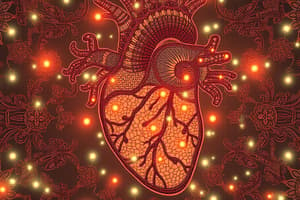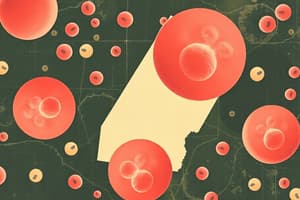Podcast
Questions and Answers
What is the significance of assessing alveolar deadspace in respiratory conditions?
What is the significance of assessing alveolar deadspace in respiratory conditions?
- It measures the volume of anatomical deadspace.
- It evaluates airway resistance.
- It determines the presence of lung cancer.
- It indicates the effectiveness of gas exchange. (correct)
Which of the following is NOT a typical assessment technique in a physical examination for respiratory issues?
Which of the following is NOT a typical assessment technique in a physical examination for respiratory issues?
- Auscultation
- Observation of breathing pattern
- Palpation
- Electrocardiogram (correct)
Which factor is considered a contraindication to performing spirometry?
Which factor is considered a contraindication to performing spirometry?
- Chronic respiratory issues
- Recent haemorrhage (correct)
- History of effective sputum production
- Normal vital signs
What does a normal FEV1/FVC ratio indicate?
What does a normal FEV1/FVC ratio indicate?
Why is observing the chest shape relevant during a respiratory examination?
Why is observing the chest shape relevant during a respiratory examination?
In the context of respiratory assessment, what does elastic resistance of the lung relate to?
In the context of respiratory assessment, what does elastic resistance of the lung relate to?
Which process describes the exchange of gases in the alveoli and blood?
Which process describes the exchange of gases in the alveoli and blood?
What is the purpose of assessing coughing effort during a respiratory examination?
What is the purpose of assessing coughing effort during a respiratory examination?
Which respiratory condition is suggested by an acute disorder like vomit fever?
Which respiratory condition is suggested by an acute disorder like vomit fever?
What is the role of pulmonary surfactant?
What is the role of pulmonary surfactant?
In a pulmonary system, what characterizes non-dependent regions during ventilation?
In a pulmonary system, what characterizes non-dependent regions during ventilation?
What phenomenon helps to minimize V/Q mismatch during expiration?
What phenomenon helps to minimize V/Q mismatch during expiration?
What does hypoxic pulmonary vasoconstriction primarily seek to achieve?
What does hypoxic pulmonary vasoconstriction primarily seek to achieve?
Anatomical deadspace refers to which part of the respiratory system?
Anatomical deadspace refers to which part of the respiratory system?
What does the transpulmonary pressure difference represent?
What does the transpulmonary pressure difference represent?
Which statement best describes physiological deadspace?
Which statement best describes physiological deadspace?
What is primarily affected in patients with COPD during expiration?
What is primarily affected in patients with COPD during expiration?
In comparing asthma and COPD, which feature is specifically indicative of asthma?
In comparing asthma and COPD, which feature is specifically indicative of asthma?
What occurs during respiratory failure type 1?
What occurs during respiratory failure type 1?
Which of the following is a common clinical presentation of COPD?
Which of the following is a common clinical presentation of COPD?
Which factor primarily decreases lung compliance in restrictive diseases?
Which factor primarily decreases lung compliance in restrictive diseases?
Which measurement is indicative of air flow limitation in COPD?
Which measurement is indicative of air flow limitation in COPD?
What pharmacological treatment is commonly used for exacerbations of COPD?
What pharmacological treatment is commonly used for exacerbations of COPD?
When measuring lung function, which ratio indicates normal function?
When measuring lung function, which ratio indicates normal function?
Which of the following components does not directly contribute to airflow limitation in COPD?
Which of the following components does not directly contribute to airflow limitation in COPD?
What is the primary issue with uniform ventilation in patients with COPD?
What is the primary issue with uniform ventilation in patients with COPD?
What is the primary purpose of pursed lip breathing in COPD management?
What is the primary purpose of pursed lip breathing in COPD management?
Which type of lung cancer accounts for 85% of cases?
Which type of lung cancer accounts for 85% of cases?
Which component is NOT part of the TNM staging system for lung cancer?
Which component is NOT part of the TNM staging system for lung cancer?
What is the recommended caloric uptake for someone with greater than 3-4% body surface area burn?
What is the recommended caloric uptake for someone with greater than 3-4% body surface area burn?
What is the main focus during the exercise testing for individuals with COPD?
What is the main focus during the exercise testing for individuals with COPD?
Which of the following is an abnormal sign that may be observed during exercise testing?
Which of the following is an abnormal sign that may be observed during exercise testing?
What is the sequence of steps for managing psychosocial support in COPD patients?
What is the sequence of steps for managing psychosocial support in COPD patients?
What is a key component of the role of physiotherapy in early burn management?
What is a key component of the role of physiotherapy in early burn management?
Which technique is used for improving the effectiveness of breathing in individuals managing COPD?
Which technique is used for improving the effectiveness of breathing in individuals managing COPD?
What does mMRC stand for in the context of assessing dyspnea level?
What does mMRC stand for in the context of assessing dyspnea level?
How does excessive oxygen therapy potentially affect nitrogen levels in the lungs?
How does excessive oxygen therapy potentially affect nitrogen levels in the lungs?
What is a possible consequence of oxygen-induced hypercapnia?
What is a possible consequence of oxygen-induced hypercapnia?
Which clinical sign is associated with pneumonia?
Which clinical sign is associated with pneumonia?
What is one of the roles of pulmonary rehabilitation in patients with interstitial lung disease?
What is one of the roles of pulmonary rehabilitation in patients with interstitial lung disease?
In patients with acute lung injury or ARDS, which of the following is commonly observed?
In patients with acute lung injury or ARDS, which of the following is commonly observed?
What is a clinical manifestation of pneumothorax?
What is a clinical manifestation of pneumothorax?
Which condition may lead to secondary polycythemia due to increased blood viscosity?
Which condition may lead to secondary polycythemia due to increased blood viscosity?
What is the primary focus of breathing exercises in pulmonary rehabilitation?
What is the primary focus of breathing exercises in pulmonary rehabilitation?
What does high flow oxygen therapy do to sputum consistency?
What does high flow oxygen therapy do to sputum consistency?
Which assessment is not typically used in diagnosing pneumonia?
Which assessment is not typically used in diagnosing pneumonia?
What is a common education topic included for asthma patients?
What is a common education topic included for asthma patients?
What could be a complication of low respiratory rates in patients?
What could be a complication of low respiratory rates in patients?
Which factor is NOT typically associated with impaired ciliary clearance?
Which factor is NOT typically associated with impaired ciliary clearance?
What is the effective approach for managing acute symptoms in a patient with asthma?
What is the effective approach for managing acute symptoms in a patient with asthma?
Flashcards
Respiratory Exchange
Respiratory Exchange
The process where O2 and CO2 are exchanged between alveoli and the blood.
Airway Bypass
Airway Bypass
An alternative method of clearing airways blocked by mucus or other substances.
Pulmonary Surfactant
Pulmonary Surfactant
A mixture of phospholipids and apoproteins that reduces surface tension in the alveoli.
Ventilation
Ventilation
Signup and view all the flashcards
Ventilation/Perfusion Mismatch
Ventilation/Perfusion Mismatch
Signup and view all the flashcards
Hypoxic Pulmonary Vasoconstriction
Hypoxic Pulmonary Vasoconstriction
Signup and view all the flashcards
Anatomical Dead Space
Anatomical Dead Space
Signup and view all the flashcards
Nondependent Ventilation/Perfusion
Nondependent Ventilation/Perfusion
Signup and view all the flashcards
Alveolar Deadspace
Alveolar Deadspace
Signup and view all the flashcards
Spirometry
Spirometry
Signup and view all the flashcards
Maximal inspiratory/expiratory effort
Maximal inspiratory/expiratory effort
Signup and view all the flashcards
FEV1/FVC
FEV1/FVC
Signup and view all the flashcards
Contrainidications for spirometry
Contrainidications for spirometry
Signup and view all the flashcards
Respiratory Assessment
Respiratory Assessment
Signup and view all the flashcards
Physical Exam (Respiratory)
Physical Exam (Respiratory)
Signup and view all the flashcards
Normal Vital Signs
Normal Vital Signs
Signup and view all the flashcards
COPD
COPD
Signup and view all the flashcards
Expiration Problem (COPD)
Expiration Problem (COPD)
Signup and view all the flashcards
FEV1/FVC Ratio
FEV1/FVC Ratio
Signup and view all the flashcards
Asthma vs. COPD
Asthma vs. COPD
Signup and view all the flashcards
Restrictive Lung Disease
Restrictive Lung Disease
Signup and view all the flashcards
COPD Presentation
COPD Presentation
Signup and view all the flashcards
Assessment of COPD Exacerbation
Assessment of COPD Exacerbation
Signup and view all the flashcards
Respiratory Failure Type 1
Respiratory Failure Type 1
Signup and view all the flashcards
Respiratory Failure Type 2
Respiratory Failure Type 2
Signup and view all the flashcards
Treatment for COPD exacerbation
Treatment for COPD exacerbation
Signup and view all the flashcards
Hypoxemia
Hypoxemia
Signup and view all the flashcards
PaO2
PaO2
Signup and view all the flashcards
PaCO2
PaCO2
Signup and view all the flashcards
Hypercapnia
Hypercapnia
Signup and view all the flashcards
Hypoxic Vasoconstriction
Hypoxic Vasoconstriction
Signup and view all the flashcards
V/Q Mismatch
V/Q Mismatch
Signup and view all the flashcards
O2 Toxicity
O2 Toxicity
Signup and view all the flashcards
CO2 Narcosis
CO2 Narcosis
Signup and view all the flashcards
Incentive Spirometry
Incentive Spirometry
Signup and view all the flashcards
PEP/OPEP
PEP/OPEP
Signup and view all the flashcards
Premature Expiration
Premature Expiration
Signup and view all the flashcards
Wheezing
Wheezing
Signup and view all the flashcards
SABA
SABA
Signup and view all the flashcards
LABA
LABA
Signup and view all the flashcards
Clubbing
Clubbing
Signup and view all the flashcards
Dyspnea Level
Dyspnea Level
Signup and view all the flashcards
mMRC
mMRC
Signup and view all the flashcards
COPD Exercise Test
COPD Exercise Test
Signup and view all the flashcards
Pursed Lip Breathing
Pursed Lip Breathing
Signup and view all the flashcards
Early Burn Management
Early Burn Management
Signup and view all the flashcards
Skin Layers
Skin Layers
Signup and view all the flashcards
Burn Severity
Burn Severity
Signup and view all the flashcards
Burn Management Role of a Physician
Burn Management Role of a Physician
Signup and view all the flashcards
Lung Cancer: NSCLC
Lung Cancer: NSCLC
Signup and view all the flashcards
Lung Cancer: CSCLC
Lung Cancer: CSCLC
Signup and view all the flashcards
Study Notes
Cardio Revise
- Cardio Revise - title of learning material
Stage of Respiration
- Stage 1: Ventilation - mechanical process of air movement in and out of the body
- Stage 2: External Respiration - exchange of gases (O2 and CO2) between the alveoli and blood
- Stage 3: Gas Transport - movement of gases in the blood
- Stage 4: Internal Respiration - exchange of gases between the blood and body cells
Anatomical Aspects
- Upper Respiratory Tract - nose, pharynx, larynx, and trachea
- Lower Respiratory Tract - bronchi, bronchioles, and alveoli
Functional Aspects
- Conducting Zone - from nose to bronchioles, responsible for gas conduction
- Respiratory Zone - alveoli ducts to alveoli, site of gas exchange
Pressure Relationships
- Atmospheric Pressure (Patm) - pressure of the air surrounding the body
- Intrapulmonary Pressure (Ppul or Palv) - pressure within the lungs
- Intrapleural Pressure (Pip or Ppl) - pressure in the pleural cavity, always slightly lower than intrapulmonary pressure
- Transpulmonary Pressure - difference between intrapulmonary and intrapleural pressures; crucial for lung expansion
Additional Aspects
- Pulmonary Surfactant - mixture of phospholipids and proteins, reducing surface tension in alveoli, essential for lung function
- Airway Bypass - alternate airway to bypass blocked airways in the lung; vital for removing secretions
- Ventilation-Perfusion Mismatch - situation where ventilation and blood flow in different sections of the lungs do not match, resulting in inadequate gas exchange
- Non-dependent Ventilation - higher compliance, more blood flow to the base
- Dependent Ventilation - higher compliance, less blood flow to the base
Added Sounds During Auscultation
- Continuous Sounds (Wheezes) - high-pitched (narrowed airway) or low-pitched (rhonchi-thick secretions)
- Discontinuous Sounds (Crackles) - fine (fibrosis/fluid-late inspiratory) or coarse(secretions)
- Normal Lung Sounds
Normal Vital Signs and Arterial Blood Gas Values
- Blood Pressure (SBP, DBP)
- Heart Rate
- Respiratory Rate
- SpO2 (Oxygen Saturation)
Normal and abnormal Acid-base disturbances
- Respiratory Acidosis/Alkalosis - related to the level of CO2
- Metabolic Acidosis/Alkalosis - related to the level of bicarbonate (HCO3)
Respiratory Failure
- Type 1 - hypoxemia (low oxygen) with normal or low carbon dioxide
- Type 2 - hypercapnia (high CO2) with low oxygen
Oxygen Therapy
- Limitation - by hemoglobin (anemia)
- Secondary Polycythemia - increased blood viscosity leading to stroke
- Hypoxic Vasoconstriction
Absorption Atelectasis
- Cause - too much oxygen intake removes nitrogen, collapsing alveoli
Oxygen-Induced Hypercapnia
- COPD patients at risk of worsening V/Q mismatch.
- Management - maintaining SpO2 around 88-92%, with 24-28% O2
Breathing Devices
- Incentive Spirometry - improves lung expansion
- PEP/OPEP - prevents collapse, facilitates secretion clearance
Inspirational Muscle Training (IMT)
- Resistance training to strengthen inhalation muscles
- Advantages - improve inspiratory muscle strength and endurance for better breathing.
Pneumonia
- Cause - inflammation or infection in airways (bronchitis) or lungs (alveoli)
- Diagnosis - X-ray reveals consolidation or patchy airspace opacities, white blood cell count is elevated, and C-reactive protein is elevated
Asthma vs COPD
- Bronchodilator response used to diagnose asthma from COPD
- Reversible airway disease .
Interstitial Lung Disease (ILD)
- Presentation- progressive shortness of breath and/ or cough, often worse with exertion.
- Cause - inflammation of lung tissue resulting in scarring
Acute Lung Injury (ALI) / Acute Respiratory Distress Syndrome (ARDS)
- Cause - rapid onset respiratory failure due to lung parenchyma or lung blood vessel injury (inflammation)
- Classification - based on the level of oxygenation (PaO2/FiO2 ratio) and pulmonary artery wedge pressure
Treatment of ALI/ARDS
- Stabilization of abnormal gas exchange, hemodynamics and hypoxia.
- Mechanical ventilation may be required including lung-protective ventilation strategy.
- Prone positioning and ECMO
- Corticosteroids
Pneumothorax
- Definition - presence of air/gas in the pleural space
- Cause - trauma or spontaneous (secondary or primary), due to underlying conditions (COPD, asthma, TB)
- Types - simple (without mediastinal shift), tension (with mediastinal shift), or open
- Clinical presentation- sudden chest pain, shortness of breath, rapid breathing, decreased blood pressure, and/or altered mental status
- Treatment - urgent treatment for tension pneumothorax, insertion of a chest tube to drain air
Pleural Effusion
- Definition - a fluid accumulation in the pleural space
- Causes - various underlying lung/heart/kidney diseases, infections, tumours
- Presentation - dyspnea, chest pain, dry cough (often associated with other underlying conditions)
Pulmonary Rehab Program
- Structure - 6-12 supervised weekly sessions (at least 12 sessions)
- Focus - cardiovascular and respiratory fitness, activity progression, and education
- Components - assessment (6MWT/Spirometry/CAT), exercises, education, self-management
Assessment of Dyspnea and COPD
- MMRC grading used to assess the severity of dyspnea in COPD
- BODE Index measures the severity of COPD based on several factors (BMI, dyspnea, exercise capacity, and presence of exacerbations).
Breathing Exercises
- Diaphragmatic Breathing - to improve efficacy of oxygen (increases lung capacity) and tidal volume.
- Pursed Lip Breathing - to create a positive pressure in the airway to facilitate breathing exhalation, relieves SOB.
Abnormal Signs in Exercise
- Heart rate - insufficient increase or delay to decrease after exercise.
- Blood Pressure (SBP and DBP) - elevated values that do not return to baseline after exercising
Burn Injuries
- Types of burns- epidermal, dermal, and subdermal
- Clinical presentation- variable depending on the degree and area of involvement
- Initial management - involves immediate airway support, thermal protection, and pain control
- Role of physiotherapy- assessment, management of airway clearance and sputum, and nebulization
Stages of Lung Cancer
- Non-small cell lung cancer (NSCLC) - more common, tends to be adenocarcinoma or squamous cell carcinoma.
- Small cell lung caner (SCLC) - less common, grows rapidly and spreads quickly
- Staging is done using tumor size, lymph node involvement, and presence of metastasis.
Cancer Treatment & Rehabilitation
- Prehabilitation before treatment
- Rehabilitation involves aerobic and strengthening exercises, education and support, and setting for supervised exercises.
Post-Operative Care
- High Fowler’s position - sitting upright and elevating the head to improve chest expansion postoperatively
- Breathing exercises - to prevent or resolve atelectasis, improve gaseous exchange, and facilitate secretion clearance.
Studying That Suits You
Use AI to generate personalized quizzes and flashcards to suit your learning preferences.




